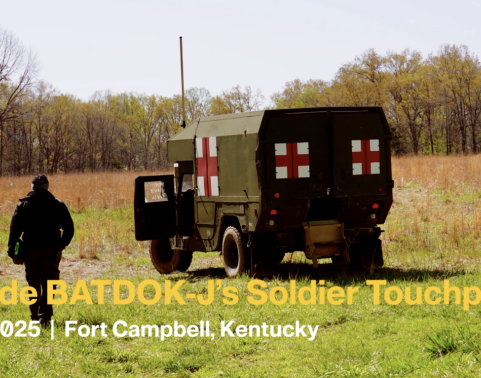Inside BATDOK-J’s Soldier Touchpoint

Soldiers at Fort Campbell’s 3rd Mobile Brigade Combat Team of the 101st Airborne Division (Air Assault) experimented with the Battlefield Assisted Trauma Distributed Observation Kit-Joint (BATDOK-J) application during a 21-day Soldier Touchpoint that started March 18. Soldiers assessed how BATDOK-J integrates with the Army’s Health Assessment Lite Operations (HALO) electronic health record under realistic, operational environments.
The BATDOK-J Soldier Touchpoint required extensive planning and close collaboration among five organizations: the Air Force Research Laboratory (AFRL), Army Medical Test and Evaluation Activity (MTEAC), Joint Operational Medicine Information Systems (JOMIS), Nett Warrior and Operational Medicine Information Systems - Army (OMIS-A). In addition, Forces Command (FORSCOM), Medical Capabilities Development Integration Directorate (MED CDID) and the Office of the Surgeon General (OTSG) provided valuable support for the exercise.
Benefits of Soldier touchpoints
The BATDOK-J Soldier Touchpoint placed cutting-edge technology directly in the hands of its intended users — combat medics facing realistic scenarios — revealing both strengths and weaknesses that might otherwise remain hidden until deployment.
“A Soldier touchpoint gives Soldiers the opportunity to touch, experiment and work with technology in a field environment,” said Col. Deon Maxwell, director of MTEAC. “This vital feedback informs future acquisition and materiel fielding decisions.”
“Soldier touchpoints are a great opportunity to deploy an application in a realistic scenario,” said Maj. Tom Hansen, capability manager for MED CDID. “It also allows us to thoroughly test the integration of a medical application with the Army’s existing software and systems.”
“We have learned more in the last couple days than we have learned in months from testing in labs,” Dr. Gregory Burnett, chief engineer, Human Effectiveness Directorate’s Product Development Branch at AFRL, said April 7. “There’s no substitute for getting Soldiers’ hands on the technology.”
Col. Matthew Paul, project manager for Integrated Personnel and Pay System – Army, thanked 101st Airborne Soldiers for providing valuable feedback on a new capability. “Nothing ever works the way it does in the lab,” Paul said. “We got a lot of good feedback to take back into our software development process.”
The Agile development advantage
BATDOK-J is developed under an Agile software development methodology that incorporates iterative, continuous enhancements based on Soldier feedback.
“We want the system to be stressed, so we can get the coders to fix the solution,” said Lt. Col. Victor Zottig, military deputy for OMIS-A. This approach embraces failure as a pathway to refinement, prioritizing early problem identification over perfection.
Real-time collaboration in action
During the Soldier Touchpoint, the cross-functional Army team “implemented a lot of late-night troubleshooting fixes,” Zottig said. “We incorporated Soldiers’ real-time feedback to develop field-expedient solutions.”
This rapid-response framework demonstrates how cross-functional teams can address complex technical challenges when working together in a unified environment. Rather than siloed development followed by testing, a Soldier touchpoint creates an integrated development cycle where technical teams can witness firsthand how their solutions perform in simulated battlefield conditions.
Benefits beyond technology
The collaborative approach to testing BATDOK-J yields benefits that extend beyond technical improvements:
- User ownership: By involving Soldiers directly in development, the BATDOK-J program builds advocates who understand the system’s capabilities and limitations.
- Cross-organizational learning: Each participating organization gains insights from other stakeholders' perspectives and expertise.
- Reduced development time: Soldiers’ real-time feedback and adjustments eliminate lengthy feedback cycles that delay deployment.
- Risk mitigation: Early identification of problems reduces the likelihood of costly fixes after full-scale deployment.
Next steps
The success of BATDOK-J ultimately depends not just on its technical capabilities but on the strength of the collaborative networks that support its continued evolution.
The Army is working closely with JOMIS on the prioritization of future BATDOK-J capabilities.
After enhancements are made to BATDOK-J based on the valuable feedback provided in the Soldier Touchpoint, the Army will get an enhanced version of the capability back in the field so Soldiers can take another look at it.
Work for Us
Join a winning team! Search for job opportunities with PEO Enterprise.
Work with Us
Help support important missions. Explore ways your company can work with PEO Enterprise.